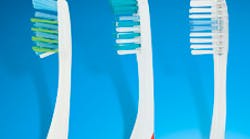Suggestions for improving plaque reduction scores
by Prof. Dr. Fridus van der Weijden and Dagmar Else Slot, RDH, MSc
In Western society, toothbrushing was introduced as a daily oral care habit in the 18th century, although it took a while for it to become common practice. It is probably due to the introduction of a plastic toothbrush with nylon filaments in the middle of the last century that a toothbrush became affordable to almost anyone. However, while there are numerous versions of manual toothbrushes on the market, there has been no clear evidence that any specific design is superior to another. Therefore, the choice of toothbrush is mainly a matter of individual preference.
Despite daily use, in practice the efficacy of manual brushing is such that it does not appear to result in optimal oral hygiene.
A systematic review was conducted to determine the average amount of plaque removed during manual brushing. The citation for the review is:
Slot DE, Wiggelinkhuizen L, Rosema NAM, Van der Weijden GA. The efficacy of manual toothbrushes following a brushing exercise: a systematic review. Int J Dent Hygiene (2012) 10:187–197.
The two databases that contain most of the dental literature (Pubmed and Cochrane) were searched for articles that addressed the efficacy of a manual toothbrush following a single brushing exercise. In order for an article to be included in the review, the subjects in the study had to be healthy adults who were not wearing an orthodontic appliance or a removable prosthesis, and who had brushed without using additional oral hygiene products. Furthermore, full mouth plaque scores had to be measured using the most frequently used indices (Silness and Loe, Quigley and Hein, and Navy).
After screening 2,119 articles, 120 were reviewed. Of these, 59 articles involving 212 separate brushing experiments ultimately met the inclusion criteria. No studies were detected that evaluated the efficacy with the use of the Silness and Loe plaque index. The plaque score reduction was 30% if measured using the Quigley and Hein index. If the Navy-index had been used, the plaque score reduction was 53%.
In summary, the overall weighted mean plaque score reduction after a single manual brushing exercise was estimated to be approximately 42%. A sub-analysis of the various bristle designs revealed that the most frequently recommended manual toothbrush -- one with a "flat-trim" bristle design -- numerically removed less plaque than a toothbrush with multi-level bristles. Based on an estimated weighted mean Navy Index plaque score reduction of 61%, the most effective toothbrush was one with angled bristles.
In conclusion, the mean plaque score reduction efficacy following a single brushing exercise being 42% is influenced by the duration of brushing and bristle design. From a practical perspective, if only approximately 40% of the plaque score is reduced, this implies that there is room for improvement. This could be partly achieved by increasing the awareness of brushers with individually tailored instructions, for example, through their use of disclosing agents and a mirror. Motivating brushers to improve their brushing technique and to brush for a sufficient length of time is also important. In studies where it was possible to perform a sub-analysis on toothbrushing time, brushing efficacy revealed that the plaque score was reduced by 27% after one minute of brushing. With two minutes of brushing, the reduction almost doubled to 41%.
Authors comments: The limited plaque score reduction following mechanical manual brushing demonstrates that there appears to be a need for additional oral hygiene tools -- for example, products for interdental cleaning or a dentifrice that contains active plaque growth-inhibiting ingredients. Dental professionals should realize this and adjust their recommendations for their individual patients. However 100% plaque score reduction, even with a (power) toothbrush, for instance, in combination with wood sticks or interdental brushes, is not realistic. Moreover, it may even not be necessary to aim for 100% removal in order to obtain an healthy oral environment. The aim of oral hygiene should be the control of bioflim to such a level that the teeth and surrounding tissues are maintained healthy. RDH
Prof. Dr. Fridus van der Weijden graduated in 1984 from the State University Dental School in Utrecht, the Netherlands, where he also received his training as a periodontist and was accredited by the Dutch Society of Periodontology in 1990. He defended his thesis titled, "The use of models and indices in plaque and gingivitis trials" in 1993. The main focus of Dr. van der Weijden's research is the treatment and prevention of periodontal diseases. He is the author of "The Power of Ultrasonics" and the co-author and co-editor of "Preventive Dentistry." Dr. van der Weijden has also authored and co-authored approximately 60 national and 150 international publications.
Dagmar Else Slot, RDH, MSc, began her career as a dental hygienist in 1997. She has taught as a dental hygiene faculty member at the universities in Utrecht and Amsterdam. Since 2007, Dagmar has worked as a researcher in the department of periodontology of the Academic Center for Dentistry Amsterdam (ACTA). She has authored and co-authored original studies and systematic reviews in several scientific journals. Dagmar is an associate editor of the International Journal of Dental Hygiene.
Past RDH Issues







